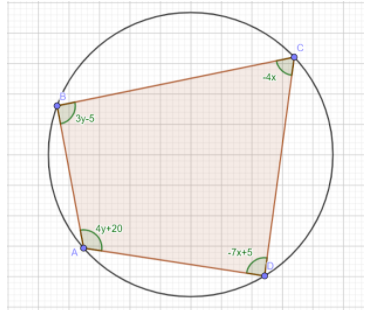
Answer
396.9k+ views
Hint: We are given angles of a cyclic quadrilateral in variables. So, we should know some basic properties of the angles of a cyclic quadrilateral. We should know that the opposite angles of a cyclic quadrilateral sum up to $180^{\circ}$. So, using that property we will construct equations and then find the answer.
Complete step by step answer:
A cyclic quadrilateral is a quadrilateral which has all its four vertices lying on a circle. It is also sometimes called inscribed quadrilateral. The circle which consists of all the vertices of any polygon on its circumference is known as the circum-circle or circumscribed circle.
The opposite angles of a cyclic quadrilateral sum up to $180^{\circ}$. So, after looking at the figure we can say that:
$3y-5+\left(-7x+5\right)=180$
$\implies -7x+3y=180$.........$\left(1\right)$
And
$4y+20+\left(-4x\right)=180$
$\implies -4x+4y=160$
$\implies -x+y=40$
$\implies y=x+40$
Putting in $\left(1\right)$
$-7x+3\left(x+40\right)=180$
$\implies -7x+3x+120=180$
$\implies -4x=60$
$\implies x=-15$
Then since $y=x+40$, we have:
$y=40-15=25$
Now, we find all the angles one by one:
$\angle A=4y+20=4\times 25+20=120^{\circ}$
$\angle B=3y-5=3\times 25-5=70^{\circ}$
$\angle C=-4x=-4\times -15=60^{\circ}$
$\angle D=-7x+5=-7\times -15+5=110^{\circ}$
Hence, all the angles have been found.
Note: You can also do the same by finding any two of the adjacent angles and then subtracting that from $180^{\circ}$. For example, say you have found the angle A to be $120^{\circ}$, then there is no need to put the value of $x$ and $y$ to find the value of the opposite angle C. You can simply subtract 120 from 180 and obtain $60^{\circ}$ as the measure of the angle C.
Complete step by step answer:
A cyclic quadrilateral is a quadrilateral which has all its four vertices lying on a circle. It is also sometimes called inscribed quadrilateral. The circle which consists of all the vertices of any polygon on its circumference is known as the circum-circle or circumscribed circle.
The opposite angles of a cyclic quadrilateral sum up to $180^{\circ}$. So, after looking at the figure we can say that:
$3y-5+\left(-7x+5\right)=180$
$\implies -7x+3y=180$.........$\left(1\right)$
And
$4y+20+\left(-4x\right)=180$
$\implies -4x+4y=160$
$\implies -x+y=40$
$\implies y=x+40$
Putting in $\left(1\right)$
$-7x+3\left(x+40\right)=180$
$\implies -7x+3x+120=180$
$\implies -4x=60$
$\implies x=-15$
Then since $y=x+40$, we have:
$y=40-15=25$
Now, we find all the angles one by one:
$\angle A=4y+20=4\times 25+20=120^{\circ}$
$\angle B=3y-5=3\times 25-5=70^{\circ}$
$\angle C=-4x=-4\times -15=60^{\circ}$
$\angle D=-7x+5=-7\times -15+5=110^{\circ}$
Hence, all the angles have been found.
Note: You can also do the same by finding any two of the adjacent angles and then subtracting that from $180^{\circ}$. For example, say you have found the angle A to be $120^{\circ}$, then there is no need to put the value of $x$ and $y$ to find the value of the opposite angle C. You can simply subtract 120 from 180 and obtain $60^{\circ}$ as the measure of the angle C.
Recently Updated Pages
Fill in the blanks with suitable prepositions Break class 10 english CBSE

Fill in the blanks with suitable articles Tribune is class 10 english CBSE

Rearrange the following words and phrases to form a class 10 english CBSE

Select the opposite of the given word Permit aGive class 10 english CBSE

Fill in the blank with the most appropriate option class 10 english CBSE

Some places have oneline notices Which option is a class 10 english CBSE

Trending doubts
Fill the blanks with the suitable prepositions 1 The class 9 english CBSE

How do you graph the function fx 4x class 9 maths CBSE

Which are the Top 10 Largest Countries of the World?

What is the definite integral of zero a constant b class 12 maths CBSE

The Equation xxx + 2 is Satisfied when x is Equal to Class 10 Maths

Differentiate between homogeneous and heterogeneous class 12 chemistry CBSE

Define the term system surroundings open system closed class 11 chemistry CBSE

Full Form of IASDMIPSIFSIRSPOLICE class 7 social science CBSE

Change the following sentences into negative and interrogative class 10 english CBSE





